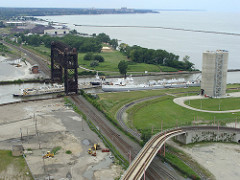The following is the text of a news release from the Chamber of Marine Commerce:
(OTTAWA) — New data indicates that construction of roads and bridges is spurring demand for dry bulk cargoes on the St. Lawrence Seaway.
According to the St. Lawrence Seaway, dry bulk shipments including coke, salt and construction-related cargoes totaled 7.6 million metric tons from April 2 to Oct. 31, up 5.8 percent compared to the same period last year. Top materials included 382,000 metric tons of stone, a 33 percent increase, and 386,000 metric tons of gypsum, a 69 percent increase. Cement products saw a healthy upswing to 1.4 million metric tons, a 14 percent increase.
“Ships have been delivering essential cargo for roadworks and other civil engineering projects across the Great Lakes/Seaway region. This robust construction activity along with Canadian grain exports helped improve tonnage numbers through the St. Lawrence Seaway,” said Chamber of Marine Commerce President Stephen Brooks.
The Port of Cleveland reported that cement is about 5 percent ahead of numbers from the same time last year. “There are a lot of construction projects going on in the Cleveland area right now,” said David Gutheil, vice president of maritime and logistics for the Port of Cleveland. “There is a big focus on highway and road projects and commercial construction like hotels as the city prepares to host the Republican National Convention next year.”
The Toledo-Lucas County Port Authority also saw an uptick in construction materials. “Dry bulk commodities are up 27 percent over the same period in 2014,” said Joe Cappel, vice president of business development for the Toledo-Lucas County Port Authority. “The Ohio Department of Transportation has a record setting $800 million road construction program underway in northwest Ohio. This massive construction program is fueled in part by shipments of products like stone and cement through Toledo’s marine terminals. Not only does the road construction boost Toledo tonnage but the projects also provide better connectivity to the terminals and reduce congestion throughout the region.”
In addition to dry bulk, Seaway traffic saw a 95 percent increase in project cargo (other general cargo), most of which was being delivered from overseas.
“Volumes of break-bulk and project cargo shipments are up at our Clure Public Marine Terminal,” said Vanta Coda, executive director of the Duluth Seaway Port Authority. “In October alone, we handled components for oil processing that will make their way to Alberta, Canada, and generators for power generation in North Dakota, as well as wind turbine blades exported from North Dakota that are heading to Germany.”
Across the board, however, total year-to-date (April 2 through Oct. 31) cargo on the Seaway was 26.9 million metric tons, down 9.4 percent. Although numbers are down, October’s surge of activity has helped to close the deficit and officials are optimistic for an improved end to the season.
About the Chamber of Marine Commerce
The Chamber of Marine Commerce is a bi-national association that represents more than 150 marine industry stakeholders including major Canadian and American shippers, ports, terminals and marine service providers, as well as domestic and international shipowners. The chamber represents the interests of its members by addressing government issues affecting marine transportation. Advocacy extends to federal, state/provincial and municipal levels of government.

